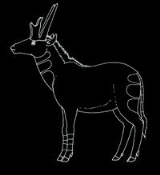
Hayoceros
Encyclopedia
Hayoceros is an extinct genus
of the family
Antilocapridae, endemic to North America
during the Early Pleistocene
epoch (1.8 mya—300,000 years ago), existing for approximately .
s located above the eyes, as in modern pronghorns, it also possessed a second, longer and unforked, pair on the back of the skull
. Most likely, males used these to fight in a fashion similar to modern pronghorns, locking horns and then pushing until the opponent gave in.
Genus
In biology, a genus is a low-level taxonomic rank used in the biological classification of living and fossil organisms, which is an example of definition by genus and differentia...
of the family
Family (biology)
In biological classification, family is* a taxonomic rank. Other well-known ranks are life, domain, kingdom, phylum, class, order, genus, and species, with family fitting between order and genus. As for the other well-known ranks, there is the option of an immediately lower rank, indicated by the...
Antilocapridae, endemic to North America
North America
North America is a continent wholly within the Northern Hemisphere and almost wholly within the Western Hemisphere. It is also considered a northern subcontinent of the Americas...
during the Early Pleistocene
Early Pleistocene
Calabrian is a subdivision of the Pleistocene Epoch of the Geologic time scale. ~1.8 Ma.—781,000 years ago ± 5,000 years, a period of ~.The end of the stage is defined by the last magnetic pole reversal and plunge in to an ice age and global drying possibly colder and drier than the late Miocene ...
epoch (1.8 mya—300,000 years ago), existing for approximately .
Taxonomy
Hayoceros was named by Skinner (1942) and named as a subgenus of Tetrameryx by Frick 1937; raised to genus level. It was assigned to Antilocapridae by Skinner (1942) and Carroll (1988).Morphology
It was about 1.8 metres (5.9 ft) in body length, and, in most respects, resembled modern pronghorns. However, in addition to the pair of forked hornHorn (anatomy)
A horn is a pointed projection of the skin on the head of various animals, consisting of a covering of horn surrounding a core of living bone. True horns are found mainly among the ruminant artiodactyls, in the families Antilocapridae and Bovidae...
s located above the eyes, as in modern pronghorns, it also possessed a second, longer and unforked, pair on the back of the skull
Skull
The skull is a bony structure in the head of many animals that supports the structures of the face and forms a cavity for the brain.The skull is composed of two parts: the cranium and the mandible. A skull without a mandible is only a cranium. Animals that have skulls are called craniates...
. Most likely, males used these to fight in a fashion similar to modern pronghorns, locking horns and then pushing until the opponent gave in.

